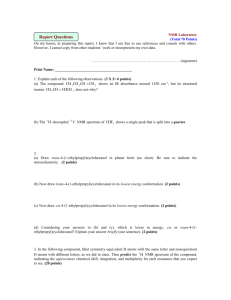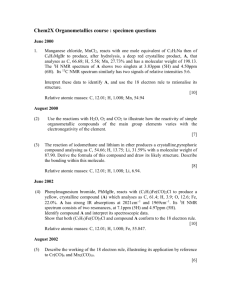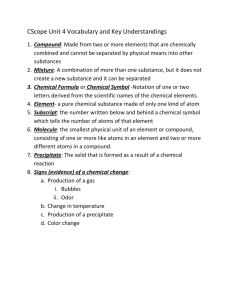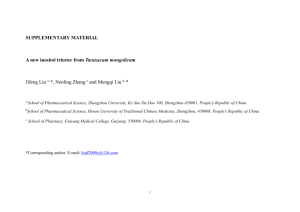Lab 13
advertisement
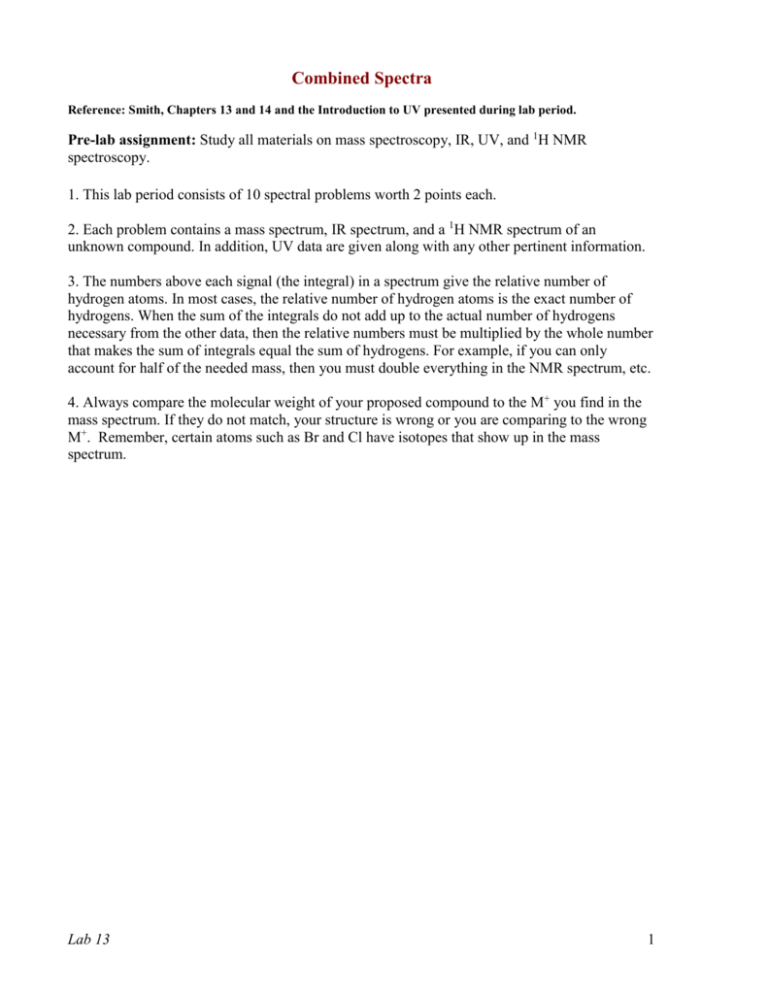
Combined Spectra Reference: Smith, Chapters 13 and 14 and the Introduction to UV presented during lab period. Pre-lab assignment: Study all materials on mass spectroscopy, IR, UV, and 1H NMR spectroscopy. 1. This lab period consists of 10 spectral problems worth 2 points each. 2. Each problem contains a mass spectrum, IR spectrum, and a 1H NMR spectrum of an unknown compound. In addition, UV data are given along with any other pertinent information. 3. The numbers above each signal (the integral) in a spectrum give the relative number of hydrogen atoms. In most cases, the relative number of hydrogen atoms is the exact number of hydrogens. When the sum of the integrals do not add up to the actual number of hydrogens necessary from the other data, then the relative numbers must be multiplied by the whole number that makes the sum of integrals equal the sum of hydrogens. For example, if you can only account for half of the needed mass, then you must double everything in the NMR spectrum, etc. 4. Always compare the molecular weight of your proposed compound to the M+ you find in the mass spectrum. If they do not match, your structure is wrong or you are comparing to the wrong M+. Remember, certain atoms such as Br and Cl have isotopes that show up in the mass spectrum. Lab 13 1 Stu No___ Sec___ Last Name_________________________________. First ______________ Compound 1 UV: > 1000 and < 100 M+ = 132 Lab 13 2 1H (d) 5H (m) 1H (d) 1H (dd) Lab 13 3 Compound 2 UV: end absorption M+ = 160 Lab 13 4 6H (t) 2H (s) 4H (q) Lab 13 5 Compound 3 UV: > 1000 M+ = 166 Lab 13 6 3H (s) 2H (s) 5H (m) Lab 13 7 Compound 4 UV: log < 2 M+ = 100 Lab 13 8 For the NMR: Compound 4 exists in two forms called tautomers. Ignore the signals marked through by an X. Analyze only the two signals labeled 2H and 6H. x 6H (s) x 2H (s) Lab 13 9 Compound 5 UV: log > 3 MS: Don’t overlook the small peak at m/e172. M+ + 2 = 172 M+ = 170 Lab 13 10 2H (s) 5H (m) Lab 13 11 Compound 6 UV: none M+ = 74 M+ + 2 = 76 Lab 13 12 2H (s) 1H (s) Although shown as singlets on the spectrum, the two signals in the 1H NMR spectrum of Compound 6 are coupled via a long-range coupling that is outside the scope of our course. Consider both signals to be singlets. Lab 13 13 Compound 7 UV: > 1000 M+ = 107 Lab 13 14 3H (s) 5H (m) 1H Lab 13 15 Compound 8 UV: log > 3 M+ = 117 Lab 13 16 3H (s) 4H (d) (d) Lab 13 17 Compound 9 UV: > 1000 M+ = 122 Lab 13 18 5H (m) 2H (t) 1H (s) 2H (t) Lab 13 19 Compound 10 UV: log > 3 M+ = 136 Lab 13 20 6H (d) 4H (d) (d) 1H (s) 1H (septet) Note: One H signal is very faint. Lab 13 21


